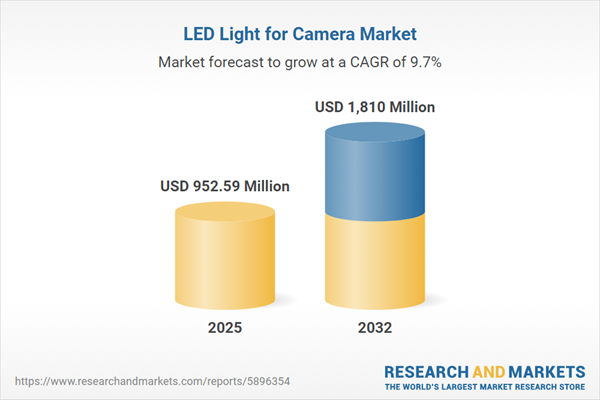Speak directly to the analyst to clarify any post sales queries you may have.
The camera LED light market is advancing content production by enabling seamless integration of adaptable lighting technologies into both legacy and emerging workflows. Senior decision-makers are seeking agile solutions that optimize processes and support resilience in dynamic production landscapes.
Market Snapshot: Camera LED Light Market Overview
The camera LED light market is experiencing robust expansion, projected to grow from USD 866.62 million in 2024 to USD 952.59 million in 2025, yielding a CAGR of 9.70%. This growth is driven by the widespread adoption of advanced lighting solutions across broadcasting, film, livestreaming, and digital content sectors. As organizations face rising production complexity and evolving quality expectations, they are increasingly prioritizing lighting solutions that streamline operations and ensure dependable output. Senior procurement teams are emphasizing strategic partnerships with suppliers capable of delivering scalable and responsive solutions. This approach enables sustained operational agility as organizations navigate rapid technological shifts and fluctuating market requirements.
Scope & Segmentation: Camera LED Light Market
- Product Types: On-camera LED lights, portable units, ring lights, studio flat panels, tubular panels, and video light bars accommodate settings from mobile shoots to large studio environments.
- Applications: Broadcast, film, livestreaming, photography, and vlogging use cases depend on adaptability, color precision, and consistent output to meet high creative and technical standards.
- End Users: Independent creators, corporate media teams, and enterprise studios each emphasize durability, specialized features, and bespoke procurement practices.
- Distribution Channels: OEM procurement, specialty and general retail, e-commerce, and wholesale distribution enable seamless project deployment both locally and internationally.
- Light Types: Bi-color, daylight, and RGB LEDs equip operational teams to maintain color accuracy and adjust to diverse environments without workflow disruption.
- Geographic Coverage: Active market engagement spans the Americas, Europe, Middle East & Africa, and Asia-Pacific. Significant adoption is seen in the US, Canada, European economic centers, as well as rapidly developing Asian and Middle Eastern markets.
- Leading Companies: Godox Photo Equipment Co., Ltd., Aperture Imaging Technology Co., Ltd., Vitec Group PLC, Yongnuo Technology Co., Ltd., NanGuang Photographic Equipment, Rotolight Ltd., Kino Flo, Dracast Inc., Lume Cube LLC, and FalconEyes Co., Ltd. drive ongoing product innovation and establish resilient supply chains in this industry.
Key Takeaways: Strategic Insights for Senior Decision-Makers
- Camera LED light solutions facilitate rapid adaptation for both portable and stationary productions, allowing organizations to keep pace with shifting creative and operational priorities.
- Emerging technologies such as chip-on-board and modular panels enhance lighting uniformity and operator flexibility, benefiting high-demand production schedules.
- Wireless control capabilities and digitally integrated productivity features empower teams to execute timely real-time adjustments, minimizing downtime during complex shoots.
- Differentiated procurement approaches are evident across regions. North American buyers focus on flexibility, European groups emphasize compliance, and Asia-Pacific organizations require solutions that scale efficiently with increasing content demands.
- The production landscape is witnessing a shift toward Southeast Asia and Latin America, strengthening supply chain robustness and reducing the impact of sourcing disruptions.
- Sustainability is influencing procurement strategies. Energy efficiency and product recyclability are being prioritized to align investments with organizational ESG commitments and to future-proof technology portfolios.
Tariff Impact: Cost and Supply Chain Considerations
Recent alterations in U.S. tariffs on electronic and LED components have introduced additional complexity to supplier sourcing. These changes highlight the importance of building diversified supplier networks and adopting proactive risk management strategies, particularly for organizations with cross-border supply chains.
Methodology & Data Sources
This report draws on structured interviews with lighting designers, senior production executives, and experienced content creators, as well as comprehensive secondary market research. This blended methodology ensures the insights provided are well-informed and relevant for executive procurement and technology decisions.
Why This Report Matters: Executive Benefits
- Facilitates smooth integration of camera LED lighting into current production workflows, optimizing technology investments in line with strategic business aims.
- Equips senior teams to anticipate and respond to regulatory, market, and sustainability challenges with operational strategies that enhance long-term stability.
- Provides actionable, data-driven recommendations to maximize resource efficiency, manage spending effectively, and address supply chain uncertainties at regional and global levels.
Conclusion
This report enables senior leaders to refine lighting strategies, enhance operational agility, and maintain reliability as creative and technical production requirements evolve.
Additional Product Information:
- Purchase of this report includes 1 year online access with quarterly updates.
- This report can be updated on request. Please contact our Customer Experience team using the Ask a Question widget on our website.
Table of Contents
3. Executive Summary
4. Market Overview
7. Cumulative Impact of Artificial Intelligence 2025
Companies Mentioned
The companies profiled in this LED Light for Camera market report include:- Godox Photo Equipment Co., Ltd.
- Aperture Imaging Technology Co., Ltd.
- Vitec Group PLC
- Yongnuo Technology Co., Ltd.
- NanGuang Photographic Equipment Co., Ltd.
- Rotolight Ltd.
- Kino Flo, LLC
- Dracast Inc.
- Lume Cube LLC
- FalconEyes Co., Ltd.
Table Information
| Report Attribute | Details |
|---|---|
| No. of Pages | 183 |
| Published | October 2025 |
| Forecast Period | 2025 - 2032 |
| Estimated Market Value ( USD | $ 952.59 Million |
| Forecasted Market Value ( USD | $ 1810 Million |
| Compound Annual Growth Rate | 9.7% |
| Regions Covered | Global |
| No. of Companies Mentioned | 11 |









